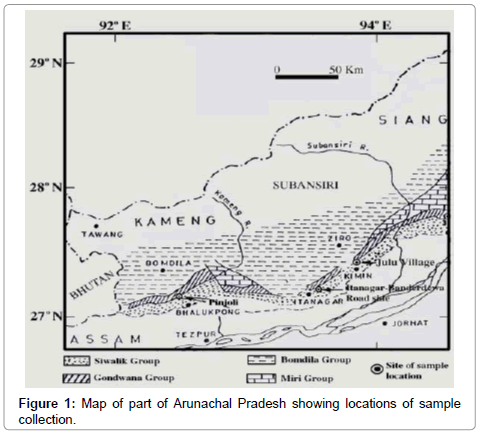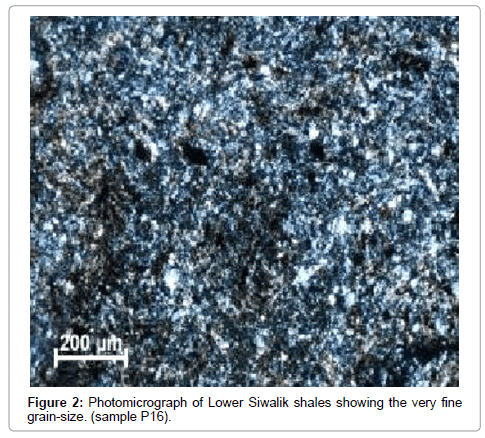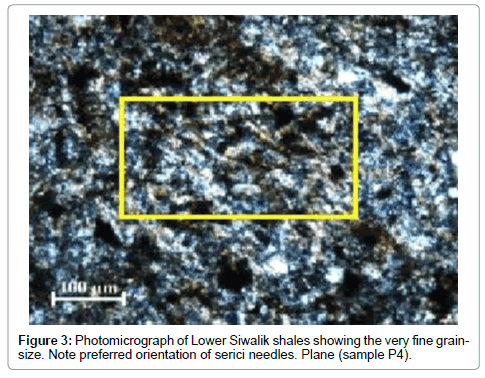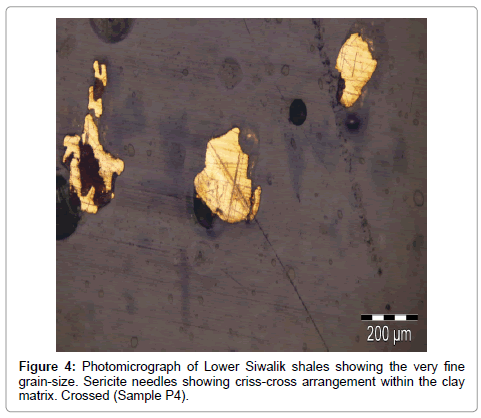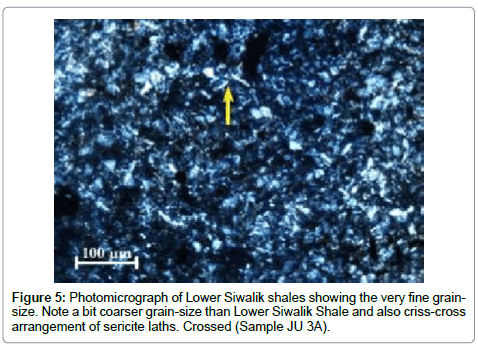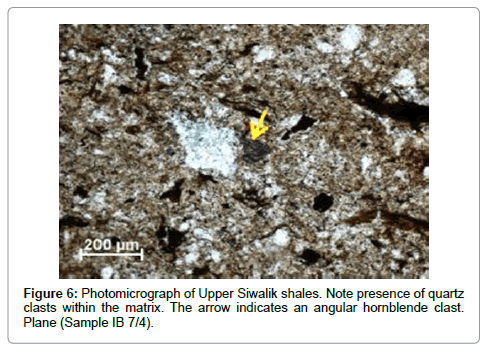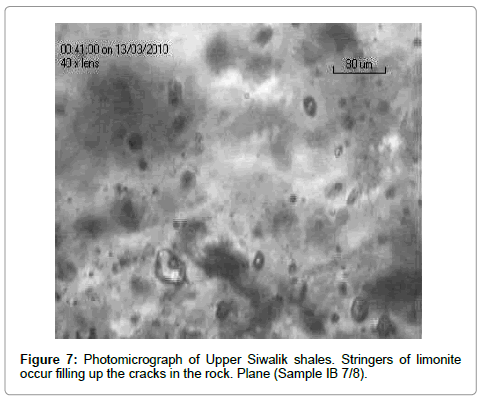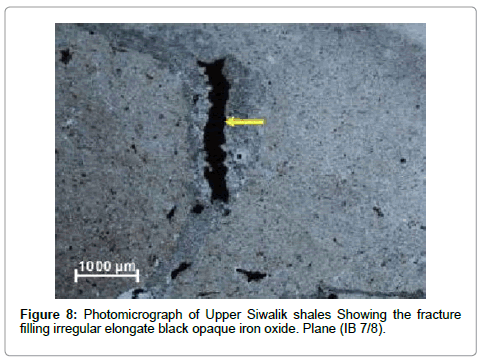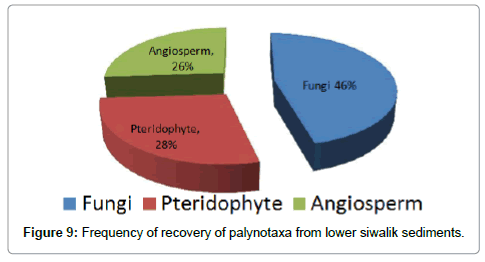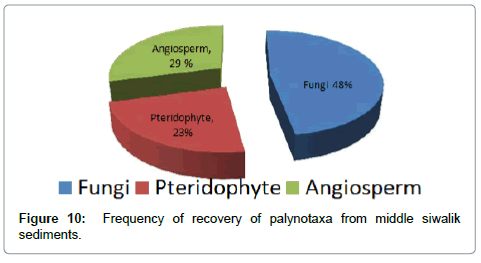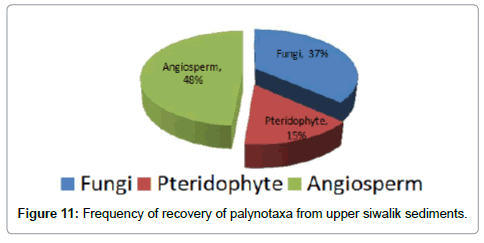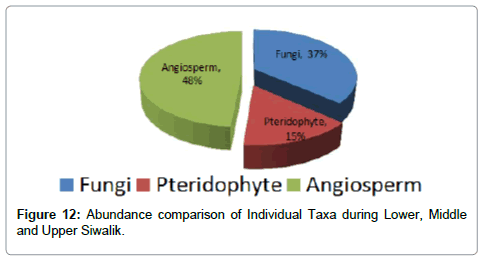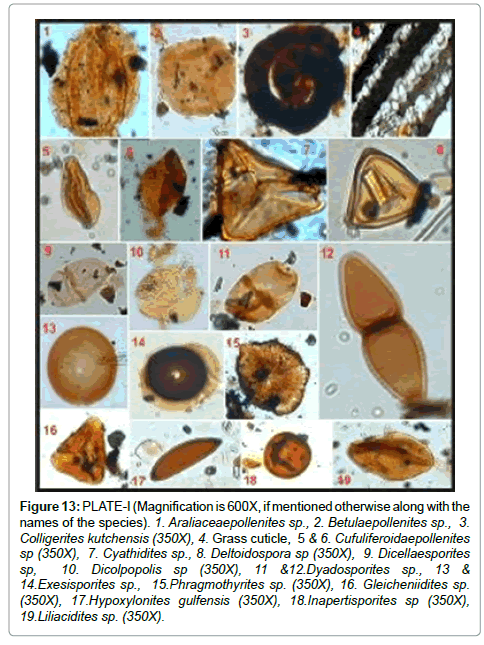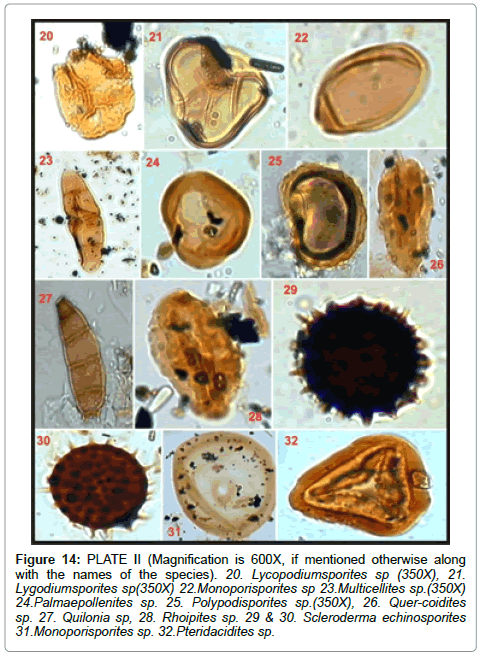Palyno-petrographical Study of the Siwalik Rocks of Some Areas of Arunachal Pradesh, North-Eastern India to Understand Palaeo-climatic Evolution of this Region
Received: 07-Sep-2015 / Accepted Date: 21-Sep-2015 / Published Date: 31-Oct-2015 DOI: 10.4172/2157-7617.1000307
Abstract
The palynological assemblages within the Siwalik shale rock samples from some areas of Arunachal Pradesh is studied to determine the palaeoclimatic condition. The petrographic study of the Shales also taken as the supportive to the determined palaeoclimate by the study of Palynological assemblages of 32 species and 30 genera taken separately from three distinct Siwalik strata, upper, middle and lower, collected from open exposures of Itanagar Banderdewa Roadside, Julu Village, and Pinjoli area of Arunachal Pradesh. The Palyno-petrographic study overall suggests that, during the lower siwalik, the region was highly coastal influenced with a dominating Tropical, humid climate. During the middle Siwalik, coastal influence was lowered, which shows coastline getting wiped out, and the temperature condition of Tropical- Sub-tropical climate. Upper Siwalik shows a further decreased coastal influence, with mainly a sub-tropical climate with an indication of temperate condition, which is indicative and supportive for the Pleistocene Glaciation in the global geological history.
Keywords: Arunachal; Palynology; Paleoclimatology; Siwalik
9031Introduction
The area of study includes some areas adjacent to Itanagar- Banderdewa Road and some areas of Julu village of Papumpare district where Upper and Middle Siwalik stratas are exposed respectively. The area of study also includes Pinjoli sector of West Kameng district where Lower Siwalik bedding have exposures. Both of these two districts are situated in the western part of Arunachal Pradesh, North- East India (Figure 1). The Siwalik rocks are underlain by Gondwana sequence which mainly comprises of carbonaceous shale, sandstone and coal with plant fossil. The Gondwana sequence is separated from the Lower Siwalik by Main Boundary Fault or MBF. Due to the MBF, Gondwana rocks are sometimes found overlying the Siwalik strata. The Siwalik strata are classified into three groups Lower, Middle, and Upper. The Lower Siwalik is essentially composed of well indurated sandstone, shale and siltstone, and abundant plant fossils. It is then further separated by a fault with the Middle Siwalik strata. The Middle siwalik is composed of weakly indurated sandstone with concretions, shale, siltstone and conglomerate, and abundant plant fossils. Middle and Lower Siwalik are separated by another fault. Lower Siwalik strata comprise mainly sandstone, claystone/shale and boulder beds/ gravel beds, and abundant plant fossils especially petrified and carbonized wood. Assam alluvia or the quaternary deposits cover the whole Siwalik stratigraphy. Assam alluvia are separated from the Siwalik essentially by Main Frontal Thrust or MFT. Due to this MFT Siwalik strata in a number of exposures are found to overlie the quaternary deposits. The generalized stratigraphic sequence of the Kameng Dist., in which the major part of the studied area lies, is shown in Table 1.
| NORTH | |
|---|---|
| Gondwana | carbonaceous shale, sandstone and coal with plant fossils. |
| MBF | |
| Lower Siwalik | Well indurated sandstone, shale and silt-stone, abundant plant fossils. |
| Fault | |
| Middle Siwalik | Weakly indurate sandstone with concretions, shale, siltstone and conglomerate; abundant plant fossils. |
| Fault | |
| Upper Siwalik | Sand rock, claystone/shale and boulder beds/gravel beds. abundant plant fossils especially petrified and carbonized wood |
| Main Frontal Fault | |
| SOUTH | Assam alluvia/ quaternary deposits |
Table 1: Generalized lithotectonic sequence in the Ka-meng district, Arunachal Pradesh.
Previous work
A Miocene palynoassemblage was recorded from the Siwalik rocks of lesser Himalayas of Kameng district by Dutta and Singh [1]. The assemblage also contains reworked palynomorphs of Palaeozoic and Eocene age. Dutta [2] also recovered palynomorphs from the Siwalik rocks of Kameng district. The palynoassemblage recorded from the Tertiary sediments in Arunachal Pradesh by Srivastava and Bhattacharya, largely shows the overwhelming presence of angiosperm pollen viz., Lakiapollis, Neocourperipollis, Arecipites, pteridophytic spores viz., Todisporites, Cyathidites, Striatriletes and Crassoretitriletes. At some sections presence of dinoflagellate and acritarchs indicate marine intercalation in the area during early Tertiary. This palynoassemblage also contains reworked Permian palynomorphs. The palynological assemblages comprising angiosperm pollen, pteridophytic spores, fungal remains, gymnosperm pollen, dinoflagellate cysts, acritarchs and reworked Permian morphs have been reported from the Siwalik sediments ex-posed in Kameng, Subansiri and Siang districts by Singh and Saxena [3]. Khan, has recovered a palynoassemblage from the Upper Siwalik [4] sediments of Kimin Formation (Upper Pliocene-Lower Pleistocene), exposed at the road cutting section of Papumpare district, contain abundance of fungal remains followed by angiosperm pollen grains and pteridophytic spores and complete absence of gymnosperm pollen grains. This palynoassemblage indicates the prevalence of warm humid, tropical- sub tropical climate with occasional near shore condition during Upper Pliocene-Lower Pleistocene in the area [5].
Objective Of Present Work
The objective of the present work is to study and understand the depositional environment and palaeogeography of the said area of Arunachal Pradesh during tertiary period by the palynological assemblage analysis and petrographical study as well of the collected rock samples of Siwalik shales.
Petrography
Lower Siwalik: It is a dark-colored, extremely fine grained rock composed of, in order of approximately decreasing abundance of sericite, clay, quartz, feldspar, iron oxide, biotite and chlorite. The most significant textural feature is the segregation of sericite-biotite-chlorite rich thin elongate patches (Figures 2-5). Sporadically through the rock; in such segregated patches there is distinct preferred orientation of micas along a particular direction, however, haphazard criss-cross pattern of orientation of sericite within the clay-rich part of the rock is also common. Both sericite and biotite (pleochroic from pale yellow to greenish brown) occur in the patchy segregations as thin elongate grains, occasionally forming bunches. Chlorite, apart from forming thin laths occurs also as medium sized subsequent flakes [6]. Iron oxides occur both as highly irregular brown limonitic grains as well as subhedral to anhedral equant to slightly elongate grains. Rarely thin rim of aggregates of biotite occur around black iron oxide grains. Iron ox-ide is more concentrated along the cracks. Sericite occurs within the clay commonly as sporadic needles [7].
Middle siwalik: The mineralogical composition and order of abundance is same here as in the Lower Siwalik samples. It is also a fine-grained rock, but the grain size is coarser than the Lower Siwalik samples (Figure 6).
Upper Siwalik: The mineralogical composition is mainly like the previous samples sporadic and medium sized, angular hornblende (strongly pleochroic from pale green to bluish green) thin lenticles of brown limonite occasionally show preferred orientation (Figure 7) through the fine-grained matrix [8]. The overall size of the matrix is similar to lower Siwalik. But the significant feature is the occurance of coarser clasts of quartz throughout the slide within the extremely fine grained matrix. The bluish colour of amphibole grain is due to high concentration of Na in its crystal structure. This in turn indicates high pressure metamorphism of the source rock/ provenance from where it is derived (Figure 8).
Palynology
Sample collection
The samples were collected from the exposures of Siwalik Shales from Pinjoli area of West Kameng Dist. and Itanagar-Banderdewa Roadside and Julu Village of Papumpare Dist. of Arunachal Pradesh, N-E India. These are exposure samples, not the drilled one [9,10].
Methodology
For Palynological study usual maceration technique has been adopted for recovery of palynomorphs with particular caution to avoid contamination. Each sample weighing 10 gm. was treated with 10% aqueous solution of HCL to dissolve carbonates, if any, washed thoroughly with distilled water followed by 40% HF treatment for 24 hours to remove all the silica contents. The HF-free samples were then treated with concentrated HNO3 for few hours to few days depending on the maturation status of the samples. After thorough washing the samples were treated with 5-10% KOH (to dissolve the humic matters), sieved, washed with distilled water and dried partially. The samples were then suspended in a heavy liquid of KI-CdI2 mixture adjusted to a specific gravity of 2.3. To the supernatant liquid, five times distilled water was added and then few drops of 10% glacial acetic acid were added and kept for overnight, centrifuged, washed and finally preserved in distilled water or 50% glycerin. Fine slides (5.0 cm X 2.2 cm) were prepared and preserved by cover glass for study under biological microscope. The best-preserved forms were photo-graphed and studied through Image Analyzer for detailed morphologic character analysis including measurement. Each of the bioforms is stored in a hard disk of computer. The pre-pared slides are stored in the repository of palaeobotany- palynology laboratory section of the Department of Botany, University of Calcutta.
Palynological characters
The total number of Genus recovered is 30. And the total number of species recovered is 32, of which 15 are fungal spores, 8 are pteridophytes,and 9 are angiosperms. The description of each individual Palynotaxa is given below.
The Description of the Microspores Present
Fungi
1. Genus- Colligerites Jain and Kar
Species- Colligerites kutchensis (Kar and Saxena) Jain and Kar
Description- spores multicellular, coiled, cells generally smaller, rounded in central region and bigger, Rectangular in outer region. Spore wall mostly levigate, some-times granulose. Pore may be present or absent in each cell.
2. Genus- Inapertisporites Van der Hammen ex Rouse
Species- Inapertisporites sp.
Description- Spores unicellular, sub-spheroidal to ellipsoidal, sizes between + 9-54 μm X 9-36 μm; light to dark brown in colour, in aperturate, without any folds, spore wall + 1-1.5 μm thick, psilate.
3. Genus- Monoporisporites Van der Hammen
Species- Monoporisporites sp.
Description- Spores unicellular, spherical to subspherical, ellipsoidal or obovate, sizes between + 6 X 4- 27 X 15 μm, dark brown in colour, monoporate, pore towards one side, simple, without folds. Spore wall + 1-1.5 μm thick, distinctly 2-layered, psilate.
4. Genus- Quilonia Jain and Gupta
Species- Quilonia sp.
Description- Body multicellular, filamentous, exine thick, margin undulated, Apical and Basal portions narrow, central [section] wide. Basal stalk prominent with one or two rectangular thick-walled cells; apical cell mostly in-complete, curved, central portion broad, elongate. With irregularly shaped furrow-like suture, inside the filament at different places occur one-four small, circular, ostiolate bodies.
5. Genus- Dicellaesporites Elsik
Species- Dicellaesporites sp.
Description- Spores two-celled, uniseptate, uniseriate, inaperturate, 12 μm long, 4-5.5 μm broad, slightly constricted at joining of two cells, free ends rounded; cells apparently dissimilar, one clearly larger, longer than the broad, blackish blown; other cell small, broader than long, 3 μm elements, wall ca 0.5 m thick and relatively lighter in colour; septum transverse, prominent, 1 μm broad.
6. Genus- Dyadosporites Van der Hammen
Species- Dyadosporites sp.
Description- Fungal spores bilocular, elliptical, central septum simple, cell wall psilate to finely punctuate, pore at apex of each cell, sizes between 31-42 μm X 12-16 μm.
7. Genus- Desmidiospora Thaxter
Species- Desmidiospora willoughbyi (Bradley) Ethridge, Brown and Elsik
Description- Sporangia thick-walled and flattened in the plane of the substratum, circular, 8-22 μm diameter, to irregularly elliptical, up to as much as 22 μm long. Sporangia more or less deeply lobed, the lobes being separated by distinctive narrow invaginations, many of which have a characteristic circular enlargement at the proximal ends. In larger sporangia these invaginations commonly occur in radial sets of two or three length, each shorted invaginations being be-tween two next longer invaginations. Sporangia smooth or papillate, some having the persistent, thickened zoospore cyst, 2.5-3.5 μm diameter, ad germ tube. Many have clearly defined, circular exit pore.2-2.5 μm in diameter. Zoospores and rhizoidal axis unknown.
8. Genus- Exesisporites Elsik
Species- Exesisporites sp.
Description- Unicellular, aseptate, psilate, monoporate fungal spores of circular outline with lenticular to spherical in shape. The centrally located pore in most specimens is surrounded by a dark circular patch which is interpreted as a thickened wall. This polar area is occasionally found free of the spore. Spores 17-30 μm in diameter in polar view.
9. Genus- Fractisporonites Clarke
Species- Fractisporonites sp.
Description- Fungal spores uniseriate, fragments consist of four to many rectangular to square cells, 16-28 μm high, 25-30μm diameter. Overall dimensions 25-30 X 150-230 μm, sides generally parallel.
10. Genus- Hypoxylonites Elsik
Species- Hypoxylonites sp.
Description- Oval to elongate, aseptate, bilateral, psilate fungal spores bearing an elongate scar, slit or furrow. At the level of transmitted light microscopy, at least one species is faintly sculptured. The elongate furrow is parallel to this axis and can be of various lengths. Apices rounded to pointed; usually of similar shape but some species have an attachment scar at one end; apices can also be thickened or otherwise modified. The spore wall in most specimens is generally rigid.
11. Genus- Hypoxylonites Elsik
Species- Hypoxylonites gulfensis Elsik
Description- Bilateral, reniform, aseptate, psilate fungal spores with a longitudinal furrow generally ½ or less of the length of the straight or concave side of the spore.
Overall size 7-10 X 25-32 um. Spore wall 0.25-0.5 um or slightly thicker, thickening to a maximum of 1.5 um over the ends of the spore in a few specimens; not thickened in other specimen: Aperture a narrow furrow with rounded ends. Ends of spore sub-pointed or narrowly rounded.
12. Genus- Multicellites gen. nov.
Species- Multicellites sp.
Description- Multicellate, uniserial, inaperturate fungal spores; number of cells three to many; terminal cells usually smooth, of medium thickness, usually thinner than the septa (or septal base).
13. Genus- Scolecosporites Lange and Smith
Species- Scolecosporites sp.
Description- Scoleco- phragmospore of length 15-30 X the breadth, the outline of walls and septa ladder-like.
14. Genus- Scleroderma Persoon
Species- Scleroderma echinosporites Rouse
Description- Spores small, circular in outline, with no obvious openings or pores in the wall. Ornamentation consists of fine spines radiating out from the wall. These cover the spore except at one place, which presumably was the place of attachment of the sterigma. The wall also seems coarsely punctuate, with, thin areas more or less scattered onto the surface, size range 11-15um.
15. Genus- Phragmothyrites Edwards
Species- Phragmothyrites sp.
Description- Fossil forms belonging to the Microthyriaceae, the exact position of which is uncertain, but which appear to be most closely related to Phragmothyrium as defined by Von Hohnel. No free hyphae, ascostromata sub-circular- circular, dimidiate, non-ostiolate; hyphae radially arranged, interconnected to form pseudopar-enchymatous cells; central cells + squarish sub cicular, outer cells elongated, may be setose atmargin and thickened. Cells with or without pore, generally cells in the middle region are more porate than outer ones.
Pteridophyta
1. Genus- Polypodiaceaesporites Thiergart
Species- Polypodiaceaesporites sp.
Description- Spore bean shaped, 54 um, monolete, exine 2um thick, exo-exinous layer very thin, exinelaevigate and weakly infrastructured.
2. Genus- Cyathidites Couper
Species - Cyathidites sp.
Description- Free anisopolar, trilete, laesurae distinct, long, spores triangular to sub-triangular, apices very broadly rounded and sides concave in polar view. Exine psi-late, 1.5 um thick, size ranges from 31-(35)-45 um.
3. Genus- Lygodiumsporites Potonie, Thomson and Thiergarte emend
Species- Lygodiumsporites sp.
Description- Spores sub-triangular size range 55-60 um, trilete distinct, extendint upto two-thirds the radius; exine laeviogate.
4. Genus- Deltoidospora
Species- Deltoidospora sp.
Description- Trilete spore. Outline triangular with straight to convex sides in polar view. Laesurae distinct and long, exceeding 2/3 of the radius of the spore, Exine two-layered; surface of exine psilate and kyrtomes develop along the laesuraea. Size is 32.0 X 25.0um.
5. Genus- Polypodisporites
Species- Polypodisporites sp.
Description- Trilete, roundly triangular, cingulated spore with concave sides. Y mark distict; aesuraea reaching the edge of the inner body, narrow and surrounded by exinal thickenings. Exine psilate; cingulum about 6.0 um side and psilate. Size is 35 um.
6. Genus- Pteridacidites
Species- Pteridacidites sp.
Description- Trilete cingulated spore. Contour triangular with rounded corners and slightly concave sides. Y mark dis-tinct; laesuraea thin and prominent, reaching upto the end of the spore body, but not entering the cingulum. Spore body covered, proximal and distal side with generally large polyangular, flat topped verrucae. Cingulum psilate and 4.0-6.0 um wide. Size is about 31.0-33.5uum.
7. Genus- Lycopodiumsporites Thiergart ex Delcount and Spurmont
Species- Lycopodiumsporites sp.
Description- Spores triangular, 22-35uum, trilete distinct, rays extending upto three fourths of the radius; reticulate, proximal muri ill-developed, do not anastomose to form regular meshes, distal muri form a regular reticulum. Exine 2-3um thick.
8. Genus-Gleichenidites Ross
Species- Gleichenidites sp.
Description- Miospore triangular or sub-triangular, apices rounded, sides concave, size 27um-29.5um, trilete, Y-mark slender but distinct, rays extending more than 2/3rd of the spore radius, lip thin, ends pointed. Exine 1.5um-2um thick, surface laevigate. Distal face provided with three arcuate folds and proximal intertidal thickenings.
Angiosperm
1. Genus- Palmaepollenites (Potonie) ex Potonie
Species- Palmaepollenites sp.
Description- Pollen grains bilateral, elliptical, 45uum in size, ends and bordered by thick exine, + 1.5 um thick, psilate.
2. Genus- Cupuliferoidaepollenites
Species- Cupuliferoidaepollenites sp.
Description- Tricolpate pollen grain, outline sub-circular in polar view; colpi narrow and long almost reach-ing the poles and are uniform width. Exine over 1.0 um thick, two layered; nexine is thicker than sexine; surface of exine psilate, size is about 15.0 um in diameter.
3. Genus- Betulaepollenites
Species- Betulaepollenites sp.
Description- Triporate pollen grain, outline small and triangular. Exine thin and psilate. It is characterized by the presence of arci connecting all the three pores and running nearer the equator and away from the poles. Size is 22.0 um.
4. Genus- Graminidites Cookson
Species- Graminidites media Cookson
Description- Pollen grains sub-spheroidal to sub-triangular, sides convex to slightly rounded, trilobite, poles somewhat flattened to rounded, 36-38um X 40um in size. Monoporate, pore rounded + 4 um in diameter, aspidate with thick annulus. Exine thin, surface granulate.
5. Genus- Dicolpopollis
Species- Dicolpopollis sp.
Description- Dicolpate pollen grains. Amb barrel shaped, biconvex in polar view. Colpi short, about 5.0 um deep and wide. Exine thn, about 1.0 um thick, atectate, psilate to chagrenate, size variable, small to medium. Size varies from 25.0-47.0um X 20.0-25.0um. verrucate with some scabrae.
6. Genus- Liliacidites Couper
Species- Liliacidites sp.
Description- Pollen grains elongate, ellipsoidal, monosulcate, 50 X 25um in size. Sulcus as the pollen length, open at both ends and of uniform width. Exine upto 1 um thick, tectate, surface reticulate.
7. Genus- Quercoidites
Species- Quercoidites sp.
Description- Pollen grains spheroidal in shape, 30 X 25.5um in size, tricolpate. Exine 1.5-2.0um thick, sculpture.
8. Genus- Araliaceoipollenites Potonie ex Potonie
Species- Araliaceoipollenites sp.
Description- Pollen grains oval in shape, tricolporate, 21 X 20um in size, colpi long, narrow, extending from one margin to other. Pores distinct, lalongate. Exine 2.5um thick unequal thickening of the exine in the margin, intrami-croreticulate.
9. Genus- Rhoipites Wodehouse
Species- Rhoipites sp.
Description- Pollen grains spheroidal, tricolporate, pore lalongate. Exine less than 1um in thickness, two-Layered, surface very finely ornamented.
Environmental Analysis
The Palaeo-environment can be concluded from the systematic analysis of the percentile distribution of the palynomorphs in the Upper, Middle and Lower Siwalik strata.
Conclusion
Although the systematic and quantitative analysis of the palynotaxa recovered (Table 2) shows that the predominance of fungal spores over angiosperms and pteridophytes all over the Lower and Middle Siwalik (Figures 9 and 10). However, a slight decrease in frequency of fungal elements has been observed in Middle Siwalik than that of Lower Siwalik sediments. In contrast to Lower and Middle Siwalik sediments, the sediments of Upper Siwalik age show the dominance of angiosperms over fungal spores and pteridophytes (Figure 11) [11-15]. The palynoassemblages of Lower Siwalik sediments suggest that the overall climatic conditions during the Lower Siwalik was mostly Tropical and humid. However, presence (~18% total) of Cupuliferodaepollenites sp. and Polypodiisporites sp. indicates towards a slight influence of temperate climate (Figure 12). Cosmopolitan Graminidites sp. was present as usual. A major percentage of Palmae indicates that the region was mainly coastal. The thallophytes dominated all over. In Middle Siwalik, frequency of recovery of palm pollen grains of Dicolpopolis sp. and Palmaepollenites sp. Decreased (Figure 12) than that of Lower Siwalik sediments. This indicates that the coastal influence is lowered during the Middle Siwalik times. The pteridophytes, which grow in the tropical to sub-tropical condition, dominate the pteridophytic assemblage. So the overall climatic condition during Middle Siwalik was mostly tropical to Subtropical with a lowered coastal influence. Frequency of Palmae has been reduced in The Upper Siwalik sediments than Lower and Middle Siwalik sediments indicating a lesser influence of coastal environment in the Upper Siwalik. A reduced recovery of thallophytes indicates a less humid condition (Figure 11).
| Recovered Palynotaxa | Nearest living Relative |
Siwalik (Arunachal Pradesh) | Habit | Climate/Environment | ||||||||||||
|---|---|---|---|---|---|---|---|---|---|---|---|---|---|---|---|---|
| Lower | Middle | Upper | ||||||||||||||
| FUNGI | ||||||||||||||||
| Inapertisporitessp | Fungi imperfecti | _ | + | + | Thallo- phyta |
Tropical, Humid | ||||||||||
| Monoporisporitessp | Fungi imperfecti,amerosporae | + | + | _ | Thallo-phyta | Tropical, Humid | ||||||||||
| Quiloniasp | Fungi imperfecti,phragmosporae | _ | _ | + | Thal-lophyta | Tropical, Humid | ||||||||||
| Dicellaesporitessp | Fungi imperfecti | _ | + | _ | Thal-lophyta | Tropical, Humid | ||||||||||
| Dyadosporitessp | Fungi imperfecti | _ | _ | + | Thal-lophyta | Tropical,Humid | ||||||||||
| Desmidiosporawilloughbyi | Fungi imperfecti,amerosporae | _ | _ | + | Thal-lophyta | Tropical,Humid | ||||||||||
| Exesisporitessp | Fungi imperfecti | _ | _ | + | Thal- lophyta | Tropical,Humid | ||||||||||
| Fractisporonitessp | Fungi imperfecti, phragmosporae | _ | + | _ | Thal- lophyta | Tropical,Humid | ||||||||||
| Hypoxylonitessp | Fungi imperfecti, amerosporae |
+ | + | + | Thal- lophyta | Tropical,Humid | ||||||||||
| Hypoxylonites gulfensis |
Fungi imperfecti, amerosporae |
_ | + | _ | Thal- lophyta | Tropical,Humid | ||||||||||
| Multicellitessp | Fungi imperfecti, phragmosporae | _ | + | _ | Thal- lophyta | Tropical,Humid | ||||||||||
| Scolecosporitessp | Fungi imperfecti, phragmosporae | _ | _ | + | Thal- lophyta | Tropical,Humid | ||||||||||
| Scleroderma echi- nosporites |
Basidiomycetes, sclerodermatales |
_ | + | _ | Thal- lophyta | Tropical,Humid | ||||||||||
| Phragmothyritessp | Ascomycetes, Microtyriale | _ | + | + | Thal- lophyta | Tropical,Humid | ||||||||||
| Colligerites kutch- ensis |
Fungi imperfecti, helicosporae | + | _ | _ | Thal- lophyta | Tropical,Humid | ||||||||||
| PTERIDOPHYTES | ||||||||||||||||
| Polypodiaceaespo- rites sp. | Polipodiacaea | + | + | + | Herb | Tropical-Subtropical | ||||||||||
| Cyathidites sp. | Cyatheaeae | _ | + | + | Herb | Tropical-Subtropical | ||||||||||
| Lygodiumsporitessp. | LygodiumofSchizeaceae | + | _ | _ | Herb | Tropical-Subtropical | ||||||||||
| Deltoidospora sp. | Lindsaeaceae | _ | + | _ | Herb | Tropical-Subtropical | ||||||||||
| Polypodiisporitessp. | Denstaedtiaceae | + | + | + | Herb | Tropical- Temperate | ||||||||||
| Pteridacidites sp. | Pteridaceae | _ | + | + | Herb | Tropical-Subtropical | ||||||||||
| Lycopodiumsporitessp. | Lycopodium | + | _ | _ | Herb | Tropical-Subtropical | ||||||||||
| Gleichenidites sp. | Gleichaeniaceae | + | _ | _ | Herb | Tropical-Subtropical | ||||||||||
| ANGIOSPERMS | ||||||||||||||||
| Palmaepollenitessp. | Arecaceae | + | + | + | Tree | Tropical- Subtropical | ||||||||||
| Cupuliferoidaepol- lenitessp. | CupuliferaeFagaceae | + | _ | _ | Tree | Temperate | ||||||||||
| Betulaepollenitessp. | Betulaceae | _ | _ | + | Tree | Temperate | ||||||||||
| Graminiditesmedia | Poaceae | + | + | + | Grass | Cosmopolitan | ||||||||||
| Dicolpopolis sp. | Calamus, palmae | _ | + | + | Tree | Tropical- Subtropical | ||||||||||
| Liliacidites sp. | Liliacae | _ | _ | + | Herb | Cosmopolitan | ||||||||||
| Quercoidites sp. | Fagaceae | _ | _ | + | Herb | Subtropical Temperate |
||||||||||
| Araliaceoipol- lenitessp. | Araliaceae | + | _ | + | Herb | Tropical | ||||||||||
| Rhoipites sp. | Anacardiaceae | + | + | _ | Herb | Temperate | ||||||||||
Table 2: The chart for palynotaxa recovered from various Strata and the palaeo-environmental analysis with reference to their nearest living relatives and habit.
That means the coastline moved further away during Upper Siwalik and as effect humidity decreased [16]. And the presences of mainly Tropical to Sub-tropical taxas are dominating. But there is a
major percentage (~20% total) of Sub-tropical to Temperate condition favouring Queroidites sp. and Betulaepollenites sp. (Figure 12) Angiosperms indicates that the climatic condition was mainly Subtropical to temperate during Upper Siwalik. The large percentage of fungal spores during all over the Siwalik, however, does indicate the high rate of deposition. Petrographic study also indicates to a coastal vicinity influence (Figures 13 and 14).
Figure 13: PLATE-I (Magnification is 600X, if mentioned otherwise along with the names of the species). 1. Araliaceaepollenites sp., 2. Betulaepollenites sp., 3. Colligerites kutchensis (350X), 4. Grass cuticle, 5 & 6. Cufuliferoidaepollenites sp (350X), 7. Cyathidites sp., 8. Deltoidospora sp (350X), 9. Dicellaesporites sp, 10. Dicolpopolis sp (350X), 11 &12.Dyadosporites sp., 13 & 14.Exesisporites sp., 15.Phragmothyrites sp. (350X), 16. Gleicheniidites sp. (350X), 17.Hypoxylonites gulfensis (350X), 18.Inapertisporites sp (350X), 19.Liliacidites sp. (350X).
Figure 14: PLATE II (Magnification is 600X, if mentioned otherwise along with the names of the species). 20. Lycopodiumsporites sp (350X), 21. Lygodiumsporites sp(350X) 22.Monoporisporites sp 23.Multicellites sp.(350X) 24.Palmaepollenites sp. 25. Polypodisporites sp.(350X), 26. Quer-coidites sp. 27. Quilonia sp, 28. Rhoipites sp. 29 & 30. Scleroderma echinosporites 31.Monoporisporites sp. 32.Pteridacidites sp.
References
- Dutta SK, Singh HP (1980) Palynostratigraphy of sedimentary Formations in Arunachal Pradesh. Palynology of Siwalik rocks of Lesser Himalayas, Kameng Dist., Arunachal Pradesh. Proc. IV Int. Palynol. Conf. Lucknow (1976-77), 2: 617-626
- Dutta SK (1980) Palynostratigraphy of the sedimentary formations of Arunachal Pradesh 2. Palynology of the Siwalik equivalent rock of Kameng Dist.Geophytol 10: 5-13.
- Singh HP, Saxena RK, (1980) Occurrence of palynofossils from the Pinjor Formation (Upper Siwalik) exposed near Chandigarh. CurrSci 50: 418-419.
- Saxena RK, Singh HP (1982) A Palynological investigation of the Upper Siwalik sediments exposed along HoshiarpurUna Road Section in Punjab and Himachal Pradesh, Geophytol 12: 287-306.
- Banerjee D (1968) Siwalik Micro flora from Punjab (India). Rev PaleobotPalynol6: 171-176.
- Banerjee M (1995) Palaeobiology of Neogene sediment of Bhutan, Eastern Himalaya and environment of Deposition. BirbalSahni Centenary Volume: 41-57.
- Banerjee M (1996) Tropical estuarine angiosperm vegetation in Neogene sediments of Bhutan, Eastern Himalaya and Remarks on Palaeogeography of Siwalik foreland basins of Indi-an Subcontinent. Rheedea 6: 127-140.
- Bhandari LL, Venkatachala BS, Singh B (1977) Stratigraphy, Palynology and Paleontology of LadakhMolasse group in Kargil area. Proc. IV colloq. Indian Micropalaeont. Strat, pp: 127-133.
- Dasgupta R (1991) Palaeofloristic study of the tertiary and pre Tertiary sediments of Eastern Himalaya Foothills, Bhu-tan,UnpublishedPh.D work, University of Calcutta.
- Kumar G (1997) Geology of Arunachal Pradesh. GeolSoc India, Bangalore: 1-217.
- Mathur YK (1984) Cenozoic palynofossils, vegetation, geology and Climate of the North-Western sub Himalayan region, India. The evolution of the East Asian environment vol.IIPalaeobotany, Palaeozoology and Palaeoanthropology (ed.Robert Orr. Whyte. Centre of Asian Studies, University of Hong Kong) 2: 504-551.
- Mitra S, Bera S, Banerjee M (2000) Palynolofloral assemblage From Siwalik foredeepNeogene sediments of Darjee-ling Foothills, Eastern Himalaya. Geophytol 28: 121-127.
- Nandi B (1972) Some observations on the microflora of Middle Siwalik Sediments of Mohand (East) Field, Himachal Pradesh. Seminar Palaeo (1971):375-385.
- Nandi B (1974) Studies on the Tertiary flora of India with special Reference to the micro-flora of the Himalayan foot-hills.Unpublished doctoral thesis, University of Calcutta.
- Nandi B (1980) Further contribution on the palynostratigraphy of the Siwalik Group. ProcIVthIntPalynolConfLucknow 2: 727-734.
- Pathak NR, Banerjee M (1984) Fungal spores from the Neogene Sediments of the Eastern Himalayan foothills, Darjeeling Dist. Proc. XthInd. Coll. Micropalaeont and Stratigr. Maharashtra Assoc Cult SciPune: 245-260.
Citation: Mukherjee M (2015) Palyno-petrographical Study of the Siwalik Rocks of Some Areas of Arunachal Pradesh, North-Eastern India to Understand Palaeo-climatic Evolution of this Region. J Earth Sci Clim Change 6(9): 307. DOI: 10.4172/2157-7617.1000307
Copyright: © 2015 Mukherjee M. This is an open-access article distributed under the terms of the Creative Commons Attribution License, which permits unrestricted use, distribution, and reproduction in any medium, provided the original author and source are credited.
Share This Article
Recommended Journals
Open Access Journals
Article Tools
Article Usage
- Total views: 11851
- [From(publication date): 11-2015 - Nov 21, 2024]
- Breakdown by view type
- HTML page views: 11080
- PDF downloads: 771

